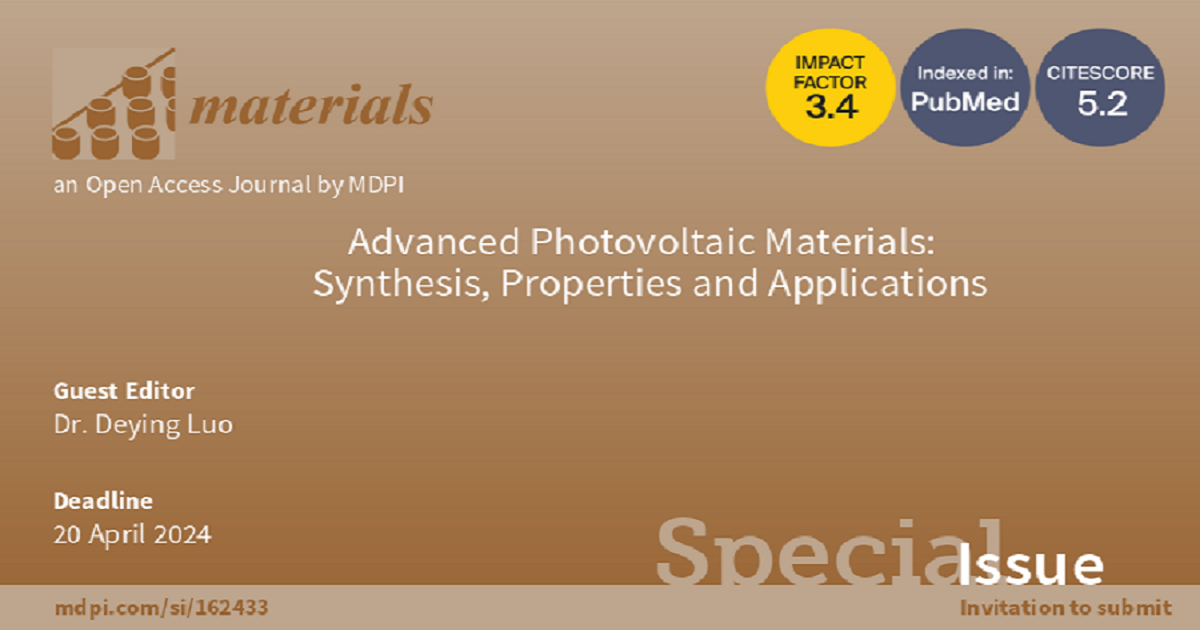Advanced Photovoltaic Materials: Synthesis, Properties and Applications
A special issue of Materials (ISSN 1996-1944). This special issue belongs to the section "Energy Materials".
Deadline for manuscript submissions: closed (20 December 2024) | Viewed by 10185

Special Issue Editor
Special Issue Information
Dear Colleagues,
Zero-carbon emissions is the global perspective on the development of a sustainable future. Solar energy, as a clean and sustainable energy, has witnessed an incredible increase in academic and industrial activity over the past several decades. Solar panels provide a direct way to convert solar energy into electricity. Silicon-based solar panels are the prevalent photovoltaic (PV) technology, yet there has been a sizable challenge to decrease the cost for decades in order to compete with the conventional fossil-fuel-based power sources without government subsidies. To seek much more affordable PV technologies, advanced materials for cost-effective PV technologies including organic solar cells, organic–inorganic hybrid solar cells, quantum-dot solar cells, compound semiconductor solar cells, dye-sensitized solar cells, perovskite solar cells, tandem/multijunction solar cells, etc. have been explored in both academia and industry. Among them, most PV technologies are still in lab-scale research and are far from practical use. Efforts in cutting-edge research outcomes into action plans for cost-effective PVs are particularly critical in the research community.
This Special issue aims to cover the most recent progress on advanced PV materials, with a particular focus on synthesis, properties, and applications. All kinds of advanced PV materials are welcome. We especially encourage the submission of manuscripts addressing hot materials such as perovskite, organic, quantum dots, organic–inorganic hybrid materials, nanostructured silicon, etc.
Dr. Deying Luo
Guest Editor
Manuscript Submission Information
Manuscripts should be submitted online at www.mdpi.com by registering and logging in to this website. Once you are registered, click here to go to the submission form. Manuscripts can be submitted until the deadline. All submissions that pass pre-check are peer-reviewed. Accepted papers will be published continuously in the journal (as soon as accepted) and will be listed together on the special issue website. Research articles, review articles as well as short communications are invited. For planned papers, a title and short abstract (about 100 words) can be sent to the Editorial Office for announcement on this website.
Submitted manuscripts should not have been published previously, nor be under consideration for publication elsewhere (except conference proceedings papers). All manuscripts are thoroughly refereed through a single-blind peer-review process. A guide for authors and other relevant information for submission of manuscripts is available on the Instructions for Authors page. Materials is an international peer-reviewed open access semimonthly journal published by MDPI.
Please visit the Instructions for Authors page before submitting a manuscript. The Article Processing Charge (APC) for publication in this open access journal is 2600 CHF (Swiss Francs). Submitted papers should be well formatted and use good English. Authors may use MDPI's English editing service prior to publication or during author revisions.
Keywords
- perovskite
- photovoltaics
- solar cells
- efficiency
- interface
Benefits of Publishing in a Special Issue
- Ease of navigation: Grouping papers by topic helps scholars navigate broad scope journals more efficiently.
- Greater discoverability: Special Issues support the reach and impact of scientific research. Articles in Special Issues are more discoverable and cited more frequently.
- Expansion of research network: Special Issues facilitate connections among authors, fostering scientific collaborations.
- External promotion: Articles in Special Issues are often promoted through the journal's social media, increasing their visibility.
- Reprint: MDPI Books provides the opportunity to republish successful Special Issues in book format, both online and in print.
Further information on MDPI's Special Issue policies can be found here.






